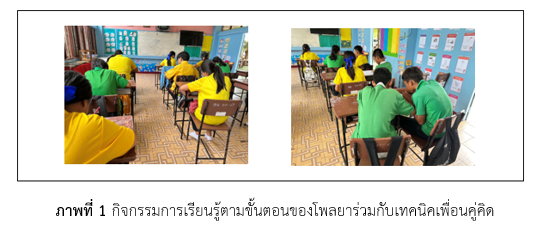การพัฒนากิจกรรมการเรียนรู้ตามขั้นตอนของโพลยาร่วมกับเทคนิคเพื่อนคู่คิดเพื่อส่งเสริมความสามารถในการแก้ปัญหา สำหรับนักเรียนชั้นมัธยมศึกษาปีที่ 1
Main Article Content
บทคัดย่อ
การวิจัยครั้งนี้มีจุดมุ่งหมาย (1) เพื่อพัฒนากิจกรรมการเรียนรู้ตามขั้นตอนของโพลยาร่วมกับเทคนิคเพื่อนคู่คิด เรื่อง สมการเชิงเส้นตัวแปรเดียว ชั้นมัธยมศึกษาปีที่ 1 เพื่อส่งเสริมความสามารถในการแก้ปัญหา ให้มีประสิทธิภาพตามเกณฑ์ 75/75 (2) เพื่อหาดัชนีประสิทธิผลของแผนการจัดการเรียนรู้ เรื่อง สมการเชิงเส้นตัวแปรเดียว ชั้นมัธยมศึกษาปีที่ 1 โดยวิธีการเรียนรู้ตามขั้นตอนของโพลยาร่วมกับเทคนิคเพื่อนคู่คิด เพื่อส่งเสริมความสามารถในการแก้ปัญหา (3) เพื่อเปรียบเทียบผลสัมฤทธิ์ทางการเรียนและความสามารถในการแก้ปัญหา เรื่อง สมการเชิงเส้นตัวแปรเดียว ชั้นมัธยมศึกษาปีที่ 1 โดยวิธีการเรียนรู้ตามขั้นตอนของโพลยาร่วมกับเทคนิคเพื่อนคู่คิด เพื่อส่งเสริมความสามารถในการแก้ปัญหาเทียบกับเกณฑ์ร้อยละ 75 ที่ได้จาก การสอนโดยใช้การจัดการเรียนรู้ตามขั้นตอนของโพลยาร่วมกับเทคนิคเพื่อนคู่คิด กลุ่มตัวอย่าง ได้แก่ นักเรียนชั้นมัธยมศึกษาปีที่ 1 ภาคเรียนที่ 2 โรงเรียนดงน้อยวิทยา จำนวน 18 คน โดยการสุ่มแบบกลุ่ม ซึ่งใช้โรงเรียนเป็นหน่วยของการสุ่ม เครื่องมือที่ใช้ในงานวิจัยครั้งนี้ ได้แก่ (1) แผนการจัดกิจกรรมการเรียนรู้ เรื่อง สมการเชิงเส้นตัวแปรเดียว ชั้นมัธยมศึกษาปีที่ 1 โดยการเรียนรู้ตามขั้นตอนของโพลยาร่วมกับเทคนิคเพื่อนคู่คิด เพื่อส่งเสริมความสามารถในการแก้ปัญหา (2) แบบทดสอบวัดผลสัมฤทธิ์ทางการเรียนวิชาคณิตศาสตร์ (3) แบบทดสอบวัดความสามารถในการแก้ปัญหาทางคณิตศาสตร์ สถิติที่ใช้ในการวิเคราะห์ข้อมูล ได้แก่ ร้อยละ ค่าเฉลี่ย ส่วนเบี่ยงเบนมาตรฐาน และ และทดสอบสมมติฐาน โดยใช้ Hotelling’s T2 ผลการวิจัย พบว่า (1) แผนการจัดกิจกรรมการเรียนรู้โดยวิธีการเรียนรู้ตามขั้นตอนของโพลยาร่วมกับเทคนิคเพื่อนคู่คิด มีประสิทธิภาพ (E1/E2) ตามเกณฑ์ 83.23 /80.19 (2) ดัชนีประสิทธิผล (E.I.) ของแผนการจัดกิจกรรมการเรียนรู้ โดยวิธีการเรียนรู้ตามขั้นตอนของโพลยาร่วมกับเทคนิคเพื่อนคู่คิด เท่ากับ 0.6871 แสดงว่า นักเรียนมีคะแนนเพิ่มขึ้นร้อยละ 68.71 (3) ผลสัมฤทธิ์ทางการเรียนที่ได้รับการจัดกิจกรรมการเรียนรู้ตามขั้นตอนของโพลยาร่วมกับเทคนิคเพื่อนคู่คิด สูงกว่าเกณฑ์ที่กำหนดที่ระดับนัยสำคัญ .05 และความสามารถในการแก้ปัญหาทางคณิตศาสตร์ที่ได้รับการจัดกิจกรรมการเรียนรู้ โดยวิธีการเรียนรู้ตามขั้นตอนของโพลยาร่วมกับเทคนิคเพื่อนคู่คิด เป็นไปตามเกณฑ์ที่กำหนด ที่ระดับนัยสำคัญ .05
Article Details

อนุญาตภายใต้เงื่อนไข Creative Commons Attribution-NonCommercial-NoDerivatives 4.0 International License.
วารสารวิทยาศาสตร์และวิทยาศาสตร์ศึกษา (JSSE) เป็นผู้ถือลิสิทธิ์บทความทุกบทความที่เผยแพร่ใน JSSE นี้ ทั้งนี้ ผู้เขียนจะต้องส่งแบบโอนลิขสิทธิ์บทความฉบับที่มีรายมือชื่อของผู้เขียนหลักหรือผู้ที่ได้รับมอบอำนาจแทนผู้เขียนทุกนให้กับ JSSE ก่อนที่บทความจะมีการเผยแพร่ผ่านเว็บไซต์ของวารสาร
แบบโอนลิขสิทธิ์บทความ (Copyright Transfer Form)
ทางวารสาร JSSE ได้กำหนดให้มีการกรอกแบบโอนลิขสิทธิ์บทความให้ครบถ้วนและส่งมายังกองบรรณาธิการในข้อมูลเสริม (supplementary data) พร้อมกับนิพนธ์ต้นฉบับ (manuscript) ที่ส่งมาขอรับการตีพิมพ์ ทั้งนี้ ผู้เขียนหลัก (corresponding authors) หรือผู้รับมอบอำนาจ (ในฐานะตัวแทนของผู้เขียนทุกคน) สามารถดำเนินการโอนลิขสิทธิ์บทความแทนผู้เขียนทั้งหมดได้ ซึ่งสามารถอัพโหลดไฟล์บทความต้นฉบับ (Manuscript) และไฟล์แบบโอนลิขสิทธิ์บทความ (Copyright Transfer Form) ในเมนู “Upload Submission” ดังนี้
1. อัพโหลดไฟล์บทความต้นฉบับ (Manuscript) ในเมนูย่อย Article Component > Article Text
2. อัพโหลดไฟล์แบบโอนลิขสิทธิ์บทความ (Copyright Transfer Form) ในเมนูย่อย Article Component > Other
ดาวน์โหลด ไฟล์แบบโอนลิขสิทธิ์บทความ (Copyright Transfer Form)
เอกสารอ้างอิง
Byerley, A. R. (2002). Using multimedia and “active learning” techniques to “energize” an introductory engineering thermodynamics class. Impact on Engineering and Science Education Conference Proceedings (pp. T3B-1). USA: IEEE.
Boonjing, A. (2008). The development of learning activities problem solving emphasizing mathematical skills based on Polya’s problem solving steps of Phathomsuksa 3 students (in Thai). Master’s thesis. Khon Kaen: Khon Kaen University.
Gagne, R. M. and Brigs, L. J. (1974). Principle of instruction design. New York: Holt, Rinehart & Winston.
Pantachord, U. (2017). Development of learning activities that promote the ability to solve academic problems. Mathematics according to Polya's steps combined with partner techniques. Journal of Mathematics, 3(5), 1-6
Polya, G. (1957). How to solve it: A new aspect of mathematical method. Princeton N.J: Princeton University Press.
Sajja, S. (2001). A development of learning activities o Polya mathematical problem solving method with cooperative learning in addition and subtraction (in Thai). Master’s thesis. Maha Sarakham: Rajabhat Maha Sarakham University.
Seenama, P. (2014). The development of learning activities package by using Polya solving problem process on linear programming for Mathayomsuksa VI students (in Thai). Master’s thesis. Phitsanulok: Naresuan University.
Tonggird, K. (2020). The development of mathematic achievement of Parthomsuksa 6 student by used Polya’s problem solving process with Think-Pair-Share on circle (in Thai). Master’s thesis. Bangkok: Ramkhamhaeng University.
Surawanichakul, V. The development of learning activities using Polya's problem solving process for develop mathematical problem solving ability in Matthayomsuksa 4 students (in Thai). Master’s thesis. Mahasarakham: Mahasarakham University.
Wilson, J. W. (1971). Evaluation of learning in secondary school mathematics. Handbook on formative and summative evaluation of student learning. USA: MCGraw-Hil.


